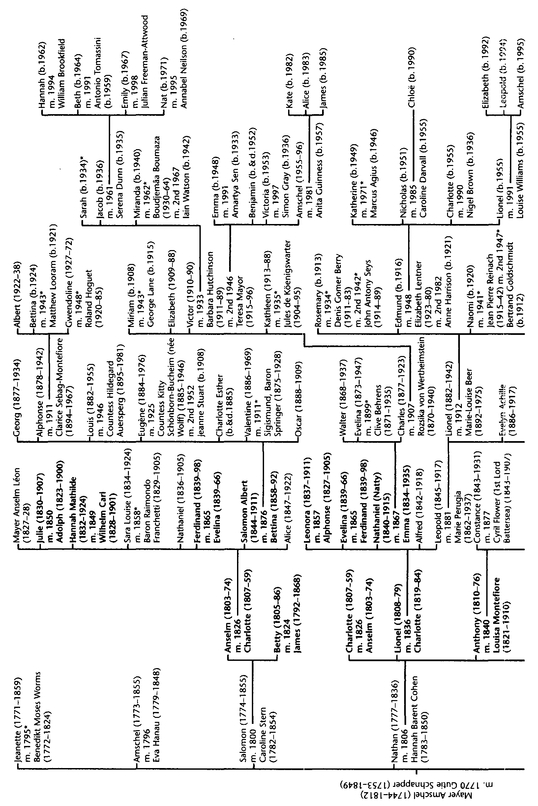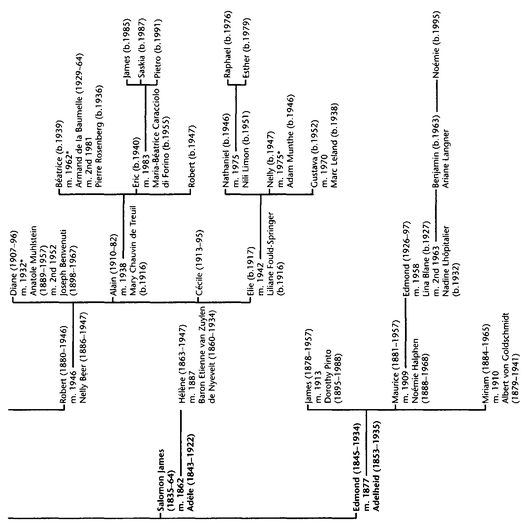Table of Contents
PENGUIN BOOKS
HOUSE OF ROTHSCHILD
Born in Glasgow in 1964, Niall Ferguson is Fellow and Tutor of Modern History at Jesus College, Oxford, as well as a political commentator and author. His previous publications include The House of Rothschild: Moneys Prophets, 1798-1848, now a Penguin paperback, The Pity of War, and the bestselling book Virtual History: Alternatives and Counterfactuals.
FOR LACHLAN
ILLUSTRATIONS IN THE TEXT
1.i: Anon., Der 99ste Geburtstag der Gromutter, Fliegende Bltter (c. 1848). Source: Fuchs, Juden in der Karikatur, p. 146.
1.ii: Anon., ONE OF THE BENEFITS OF THE JEWISH EMANCIPATION. Source: Fuchs, Juden in der Karikatur, p. 55.
2.i: The weekly closing price of French 3 per cent and 5 per cent rentes, 1835-1857. Source: Spectator.
3.i: The profits of the Naples house, 1849-1862 (ducats). Sources: AN, 132 AQ 13 and 14; Gille, Maison Rothschild, vol. II, pp. 573f.
3.ii: Profits as a percentage of capital at N. M. Rothschild & Sons, Barings and Schrders, 1850-1880. Sources: RAL, RFamFD/13F; Ziegler, Sixth great power, pp. 373-8; Roberts, pp. 527-35.
3.iii: Das goldene Kalb (1862). Source: Cowles, Rothschilds, p. 136.
3.iv: Ferrires: Auf der groen Jagd beim Rothschild (1862). Source: Wilson, Rothschild, 19th plate.
4.i: The Prussian-Austrian yield gap (Austrian minus Prussian bond yields), 1851-1875. Source: Heyn, Private banking and industrialisation, pp. 358-72.
4.ii: M. E. Schleich, Rothschilds Kriegsbereitschaft, Ein humoristisches Originalblatt, Mnchener Punsch, 19. Nr. 20 (May 20, 1866). Source: Herding, Rothschilds in der Karikatur, illustration 16. (Marburg Universittsbibliothek.)
5.i: Baron Lionel de Rothschild (The Modern Croesus), The Period (July 5, 1870). Source: Rubens, Rothschilds in caricature, plate XVII.
6.i: The weekly closing price of French 3 per cent rentes, 1860-1877. Source: Economist.
7.i: Max Beerbohm, A quiet evening in Seymour Place. Doctors consulting whether Mr Alfred may, or may not, take a second praline before bedtime. Source: Cowles, Rothschilds, p. 172.
8.i: C. Landre, Dieu protge Israel, Le Rve (April 1898). Source: Herding, Rothschilds in der Karikatur, p. 55, illustration 28. (Stadt- und Universittsbibliothek, Frankfurt am Main.)
8.ii: Lepneveu, Nathan Mayer ou lorigine des milliards, cover of Muse des Horreurs, no. 42 (c. 1900). Source: Herding, Rothschilds in der Karikatur, illustration 30. (Museum fur Kunst und Gewerbe, Hamburg.)
8.iii: Coin Harvey, The English Octopus: It Feeds on Nothing but Gold! (1894). Source: Harvey, Coins financial school, p. 215.
8.iv: Max Beerbohm, A quiet morning in the Tate Gallery ( 1907). Source: Rubens, Rothschilds in caricature, plate XXI.
8.v: Christian Schller, Die Kinder Israels ziehen ins Gelobte Land, um eine Republik zu grnden (1848). Source: Herding, Rothschilds in der Karikatur, illustration 26. (Historisches Museum der Stadt Wien).
8.vi: Anon., Auszug der Juden aus Deutschland!, Politischer Bilderbogen, Nr. 17 (1895). Source: Herding, Rothschilds in der Karikatur, illustration 27. (Sammlung Germania Judaica, Cologne.)
9.i: Combined Rothschild capital, selected years ( thousand). Source: see appendix 2, table c.
9.ii: Average annual Rothschild profits (combined houses), selected periods ( thousand). Source: see appendix 2, table c.
12.i: The weekly closing price of Russian 5 per cents, 1860-1900. Source: Economist.
13.i: Potted Peers: Lord Rothschild, The whole of the British capital having been exported to the South Pole as a result of the Budget Revolution, Lord Rothschild flies from St Swithins Lane and succeeds in escaping to the Antarctic regions disguised as a Penguin, Westminster Gazette (1909). Source: Rothschild, Dear Lord Rothschild, illustration 21.
TABLES
ACKNOWLEDGEMENTS
A full list of acknowledgements appeared in the first volume of The House of Rothschild. I would nevertheless like to take this opportunity to thank Barbara Grossman, Molly Stern and everyone else at Penguin Putnam for their work in preparing both halves of the American edition.
PREFACE
If we consider the period between 1789 and 1848 as the age of revolution, then the Rothschilds were surely its supreme beneficiaries. To be sure, the political upheavals of 1848-49 had cost them dear. As in 1830, though on a far larger scale, revolutions caused the bonds of the governments,affected to plummet in value. For the Rothschilds, who held a large proportion of their immense wealth in the form of bonds, that meant heavy losses of capital. Worse, it brought their houses in Vienna and Paris to the brink of insolvency, obliging the othersin London, Frankfurt and Naplesto bail them out. Yet the Rothschilds survived even this, the greatest of all the financial crises between 1815 and 1914, as well as the greatest revolution. Indeed, it would have been a strange irony if they had not: without revolution, they would have had little to lose in the first place.
For it had been the original French Revolution that, in 1796, had literally demolished the walls of the Frankfurt ghetto and enabled the Rothschilds to begin their phenomenal, unprecedented and since unmatched economic ascent. Before 1789, Mayer Amschel Rothschild and his familys lives had been circumscribed by discriminatory legislation. Jews were prohibited from farming, or from dealing in weapons, spices, wine and grain. They were forbidden to live outside the ghetto and were confined there at night, on Sundays and during Christian festivals. They were subject to discriminatory taxation. No matter how hard Mayer Amschel worked, first as a rare coin dealer then as a bill broker and merchant banker, there were strict and low limits to what he could achieve. All that changed when the French exported their revolution to south Germany. Not only was the Judengasse opened; the legal restrictions on the Frankfurt Jews were also largely removedthanks not least to Mayer Amschels financial influence over Napoleons henchman in the Rhineland, Karl von Dalberg. Despite the best efforts of the Frankfurt Gentiles after the French and their collaborators had been ousted, the old apartheidlike system of residential and social restriction could never wholly be restored.


















